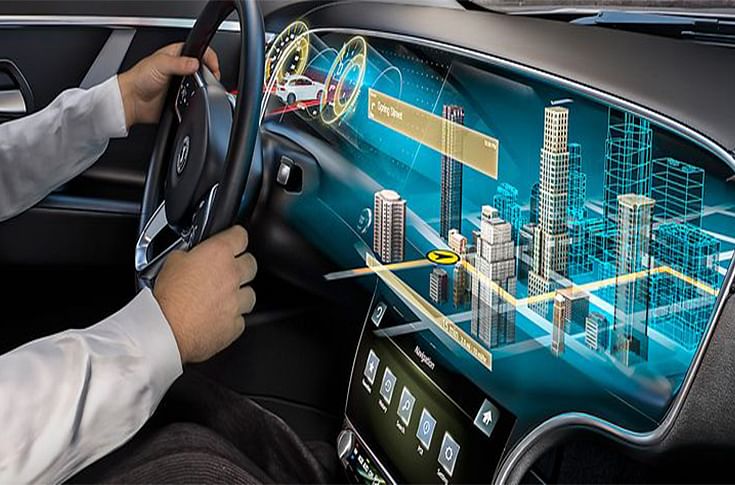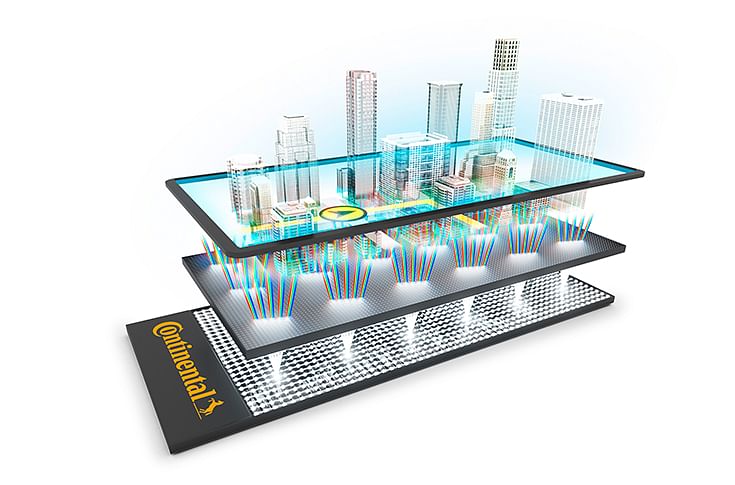Continental and Leia to unveil 3D instrument cluster at CES Asia 2019
Said to go for series production in 2022, Continental and Leia to extend every vehicle manufacturer the possibility to enhance the driver experience for their customers through 3D displays.
Continental is currently developing an innovative cockpit solution, the Natural 3D Lightfield Instrument Cluster, in cooperation with Silicon Valley company Leia. They aim to bring the third dimension into upcoming automotive vehicles, with unprecedented quality.
Lightfield displays are the next generation of medium allowing not only the comfortable perception of 3D depth but also the rendering of highlights, sparkles and other complex light effects. The technology enables information to be safely presented to the driver in real-time, allowing the driver´s interaction with the vehicle to become more comfortable and intuitive. It also allows passengers in the front and back seats to share the 3D experience with the driver.
Dr Frank Rabe, head of business unit Instrumentation & Driver HMI at Continental said, “One of today’s greatest challenges in the automotive industry is to develop intelligent concepts for the human-machine interaction. To create solutions that enhance the driver experience and allow the driver to simply and effectively interact with the vehicle without becoming distracted from the road. The new Lightfield display does not just bring the third dimension of the highest quality into the vehicle - the innovative technology also creates a new dimension of comfort and safety. In addition, our solution provides every vehicle manufacturer the possibility to enhance the driver experience for their customers and to differentiate themselves from competitors thanks to customized scopes for design.” The new system is said to go into series production by 2022.

Glasses-free 3D effect: The Lightfield Display allows a comfortable perception of 3D depth as well the rendering of highlights and other light effects.
David Fattal, Leia co-founder and CEO said, “The car is clearly the next frontier for mobile. To us it’s a bigger, more immersive version of a smartphone with full 3D awareness of its environment. It’s a logical place to deploy our growing Lightfield ecosystem of immersive gaming, video streaming, social sharing, or even e-commerce.”
The system will also offer the opportunity to leverage internal or external camera systems for video calling or augmented reality functions, a feature that the partnership intends to exploit. Leia´s Lightfield technology used for Continental’s natural 3D display does not need a head-tracker camera. Passengers in the front and back seats can also clearly see the same 3D image from their seated positions. The 3D-image produced by the Lightfield display is made up of a total of eight perspectives of the same object that subtly vary according to the point-of-view.
Kai Hohmann, product manager, display solutions at Continental said, “The newly developed light conductor with nanostructures is essential for the quality. We are not refracting the light, we are bending and guiding it precisely to attain the optimal 3D-effect needed. Only via this technology it is possible to meet the ever-increasing requirements for comfort and safety within the interior of the vehicle.”
Until recently, either parallax barriers or lenticular techniques were used to achieve a glasses-free 3D effect. They achieve a 3D effect through a special method of blocking or refracting light. Parallax barrier systems, in particular, offer only a single user application by requiring a head tracker system to adjust the 3D views towards the observer’s exact head position. Furthermore, in a similar way to a filter, they can negatively impact the perceived image quality and effectiveness of the light output in a multi-user application designed for the driver, co-driver and rear passenger. For the automotive industry, the highest quality especially for displaying information is imperative. Continental’s new 3D Lightfield application comprising Leia’s DLB (Diffractive Lightfield Backlighting) technology is claimed to offer the next level above conventional 3D displays and enables a crystal-clear screen, even when sunlight is shining directly onto it.

The 3D effect is achieved through a special method of diffracting light through a regular screen.
Zhen Peng, Leia co-founder and CTO said, “Leia has developed cutting-edge nano manufacturing process suitable for large scale and mass volume, which allowed the commercialization of its technology last year. We have bridged advanced lithography onto large-scale substrate with high yield and competitive cost, leveraging experience rooted from HP and continued in-house development over the past five years. Now we will bring this unique capability to even larger scale while complying with automotive safety standards and cost competitiveness.” Leia’s Lightfield technology made its commercial debut in the US through smartphone displays with AT&T and Verizon.
The partnership goes beyond hardware and the two companies are also collaborating on content creation and developer ecosystem support. Leia currently offers a creative toolkit to convert or create content to the Lightfield format, with automatic settings to ensure visual comfort. There are many possible applications for the new display’s Lightfield projection. Warnings from the driver assistant system will be illustrated in 3D; directions from the navigation system can be even more clearly presented; graphic display of the parking assistant – such as the 360-degree bird view assistant - will become a real eye-catcher in 3D, and the greeting by the vehicle system can be enhanced using 3D-animations so that the manufacturers logo rotates in 3D.
The collaboration plans to leverage Continental’s expertise in automotive information systems and sensors to augment Leia’s content platform ‘LeiaLoft’ and enables car manufacturers and third-party developers to easily create ‘holographic’ apps for the car of tomorrow. This automotive software development Kit (SDK) will give developers access to the car’s interior and exterior environment in full 3D and enable a host of applications from holographic navigation, park assist or augmented reality on the digital cluster or central information display.
RELATED ARTICLES
Autoliv Plans JV for Advanced Safety Electronics With China’s HSAE
The new joint venture, which is to be located strategically near Shanghai and close to several existing Autoliv sites in...
JLR to Restart Production Over a Month After September Hacking
Manufacturing operations at the Tata Group-owned British luxury car and SUV manufacturer were shut down following a cybe...
BYD UK Sales Jump 880% in September to 11,271 units
Sales record sets the UK apart as the largest international market for BYD outside of China for the first time. The Seal...






 By Autocar Professional Bureau
By Autocar Professional Bureau
 11 Jun 2019
11 Jun 2019
 17907 Views
17907 Views





 Ajit Dalvi
Ajit Dalvi




